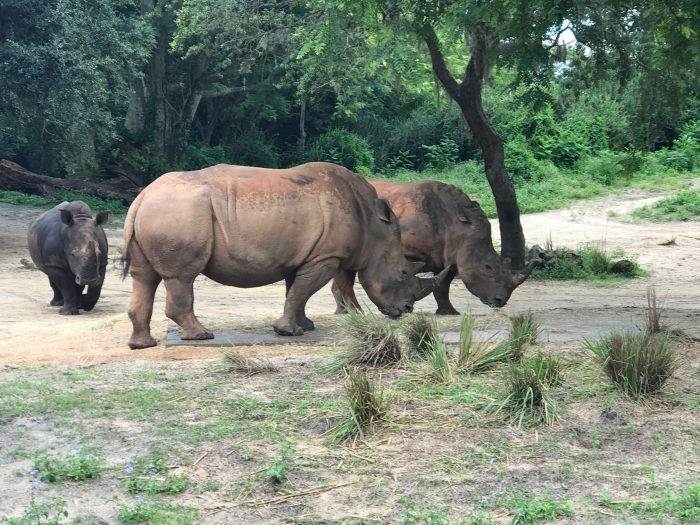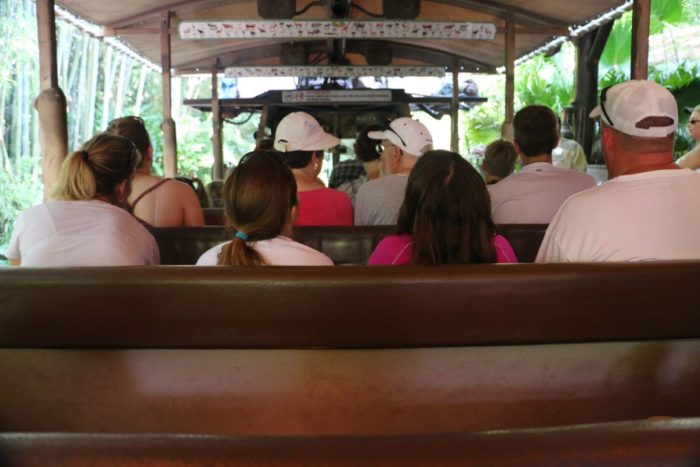Five Things to Know About Kilimanjaro Safaris
Kilimanjaro Safaris is an open-air safari through 110 acres called the Harambe Wildlife Preserve. Think of your trip as more of a photo safari during which you have an opportunity to see a wide variety of wildlife roaming “freely” through forests, grasslands, and savannas.
The wonderful (and sometimes frustrating) aspect of Kilimanjaro Safaris is that no two journeys are alike. You may see a lot of animals, or sometimes only a few! Here are the five things to know before you head for the savannah.
(If you’re in a hurry and just want details like where it is and how long the ride lasts, click here to jump straight to the Nuts and Bolts section.)
1. It Really Looks Like a Safari
What I have learned from the animal world, and what anyone will learn who studies it, is a renewed sense of kinship with the earth and all its inhabitants. – Walt Disney
Long before the Animal Kingdom existed, Walt wanted to create a ride featuring live animals at Disneyland. He originally proposed the idea while Disneyland’s Jungle Cruise was being designed. The impracticality of using animals soon became apparent and was shelved in favor of using animatronics.
Later, Disney World would offer something Disneyland couldn’t. Walt said, “Here in Florida, we have something special we never enjoyed at Disneyland… the blessing of size. There’s enough land here to hold all the ideas and plans we can possibly imagine.” So, in a sense, Walt’s dream of a ride featuring live animals came true when Kilimanjaro Safaris opened with Animal Kingdom on April 22, 1998.

Animal Kingdom, headed by lead designer Joe Rohde, was revolutionary in that this park was alive – but it didn’t feel like a zoo. Incredible care was taken to ensure it looked like an actual African reserve. Equally important was that the animals be afforded an environment in which they could thrive. This attention to detail and respect for the animals that you see on Kilimanjaro Safaris is a big part of what makes this park different.
An overhead sign in the queue puts it best: “These lands preserve a portion of Africa’s vanishing wildlife. Please show respect to all animals you meet. Your care will ensure their survival. Asante Sana – Thank You.”
2. Looks are Deceiving
“You can’t just let nature run wild.” – Walt Disney
All the animals appear to be roaming freely. Which is true, to a degree. The Imagineers have strategically placed camouflaged barriers built into the savanna, woodland, and rocky hills. This is done to prevent predators like lions, or potentially dangerous animals like hippos, from wandering where they shouldn’t. (It keeps guests safe, too!)
But don’t worry – your ride experience will still be more than a tame drive through the woods. You’ll see a wide variety of landscapes and different terrains, all designed as homes for African animals. Since animal behavior is unpredictable, you never know which animals you’ll see on your safari. This makes it a different experience each time you take the journey!

For the list-makers, some of the 34 species roaming about include giraffes, hippos, wildebeests, elephants, antelope, impalas, gazelles, crocodiles, lions, rhinos, and cheetahs! Your guide will point out which animals are visible as you drive through and provide facts about them. Like the Jungle Cruise, this ride is different every time as your guide’s information is unique to your trip.
To maximize the number of species you may be able to spot on your safari, the Imagineers have taken a few steps to encourage them to appear. Water holes, forage areas, and salt licks are placed in spots that “tempt” animals to be in sight near your path when your safari truck passes along.
Bonus fact: the rocks in the preserve can provide the animals with air conditioning during extreme heat. They can also be heated when it gets colder than it should be for the animals.
3. It’s Real, Which Means It’s Not Perfect
“I don’t want the public to see the world they live in while they’re in the park. I want them to feel they’re in another world.” – Walt Disney
Kilimanjaro Safaris is intended to be as realistic as possible to an actual safari. The entire experience is designed to help you feel as if you’re on the real thing. Truth be told, it accomplishes this goal very nicely.
However, as a consequence of the devotion to making the experience as real as possible, the roads are bumpy! As you travel through the preserve, you can be guaranteed that you’ll hit some potholes and bumps in the path that will cause your safari truck to bounce and lurch around.

Bonus fact: The ride vehicles for Kilimanjaro Safaris are custom-built trucks. They aren’t attached to a track or predetermined route of any sort. Your guide is actually driving the truck over the rough terrain. They do their best to miss any really bad dips and divots in the road, but there’s only so much room to maneuver on the paths.
As you attempt to take photos, it’s important for you to know that the vehicle isn’t guaranteed to stop at any given location. Drivers will try to accommodate guests and stop the truck when animals are visible from the path, but be prepared to click your shutter without having time to frame the perfect shot. I have a whole roll of film (yeah, it was a while ago) of blurry images as we tried our best to take pictures of wildebeests or lions to no avail.
For the best possible pictures, sit toward the outside of the seats (and Cast Members will probably recommend that little ones be seated on the inside). Even though both sides offer views of the animals, the left side is considered the best by some.
4. The Queue is a Sharp Contrast
“Whenever I go on a ride, I’m always thinking of what’s wrong with the thing and how it can be improved.” – Walt Disney
I’m totally guessing that Walt would have suggestions to improve the queue area for Kilimanjaro Safaris. To be honest, there’s not a lot to see as you wait in what is a really long queue. At one point, you pass through the “booking office.” It made me think about the plethora of details in the Jungle Cruise queue area “office.” I wished that something with similar interest and fun had been done here at the very least.

In the final stretch of your line, overhead screens show clips about the Harambe Wildlife Reserve. Frankly, there’s not a lot else to see as you wait. And because it’s an open-air queue, it’s not all that comfortable on a hot, humid Florida day despite the overhead fans.
One improvement has been made to the attraction, at least in my opinion. The earliest script for the safari included a plotline about poachers. The experience could be a little intense – even a bit scary – at times. I remember in particular one part that involved crossing a rickety bridge that appeared to almost collapse while we were on it. Honestly, I didn’t mind when either of these parts of the story were removed.
5. The Nuts and Bolts
Kilimanjaro Safaris is located at the rear of the Africa section in Disney’s Animal Kingdom Park. The ride lasts 20 minutes, plus or minus. Bonus fact: It’s the longest ride in the parks that’s not a movie or show.
The safari trucks are open-air vehicles, providing you with the widest possible range of vision. Each can hold 35 guests with 3-5 guests in a row. As you might expect, the seats aren’t easy chairs and consist of a slightly padded bench with a back.

To board, you have to take a small step up into the vehicle. There are no height restrictions for Kilimanjaro Safaris. Guests in an ECV must transfer to a standard wheelchair.
There are some significant health advisories for Kilimanjaro Safaris. Disney advises that for safety, you should be in good health and free from high blood pressure, heart, back, or neck problems, motion sickness, or other conditions that could be aggravated by this adventure. Expectant mothers should not ride. The reason for all of these is the previously discussed bumpy terrain.
Kilimanjaro Safaris is one of Animal Kingdom’s busiest attractions, along with Expedition Everest and the two Pandora attractions. Waits diminish in the late afternoon, sometimes as early as 3:30 p.m. The ride does operate when it’s raining, if possible, but it may close if the weather takes a turn for the worse.
To make the safari accessible to as many as possible, the following aids are available from Guest Services with a refundable deposit: Handheld Captioning, Video Captioning, Assistive Listening Devices, and Audio Description Devices.
Lastly, Lightning Lane via Genie+ is available.
The Bottom Line
Walt said, “You can design and create, and build the most wonderful place in the world. But it takes people to make the dream a reality.”
We think the Imagineers totally succeeded here. Unofficial Guide to Walt Disney World author, Bob Sehlinger, agrees, saying: “Having traveled in Kenya and Tanzania, I can tell you that Disney has done an amazing job of replicating the sub-Saharan east-African landscape. As on a real African safari, what animals you see, and how many, is pretty much a matter of luck. We’ve experienced Kilimanjaro Safaris more than 100 times and had a different experience on each trip.”
How many times have you taken the safari? Which animals were you most excited to see? Let us know in the comments below. Asante!






This will be my frist time on the safari at Disney world I’m so excited about the ride and I can’t wait to ride it and I love the African aminals because I’m part African
If you enjoy the Safari, I would also recommend doing the Wild Africa Trek to anyone that has a chance to do so! This experience was fantastic and goes into places that the Safari doesn’t and is a much more “up close and personal” tour of the area.